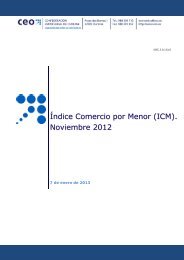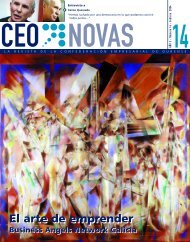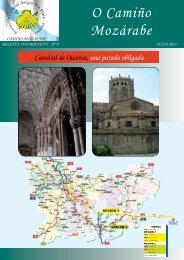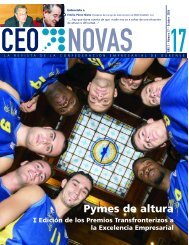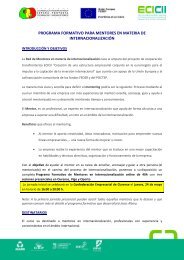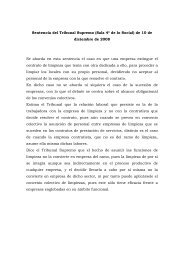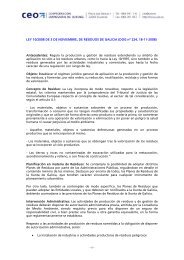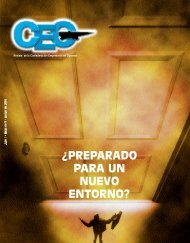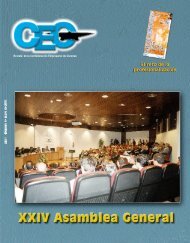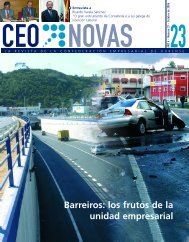boletÃn viaprata n5 para pdf.FH11 - Asociación de Amigos VÃa da ...
boletÃn viaprata n5 para pdf.FH11 - Asociación de Amigos VÃa da ...
boletÃn viaprata n5 para pdf.FH11 - Asociación de Amigos VÃa da ...
You also want an ePaper? Increase the reach of your titles
YUMPU automatically turns print PDFs into web optimized ePapers that Google loves.
Cultural <strong>Amigos</strong> Via PlataAsociación- OurenseO CamiñoAurienseCAMIÑO MOZÁRABEBOLETÍN INFORMATIVO Nº 5 JULIO 2009Mapa Vía <strong>de</strong> la Plata - Camiño Mozárabe - OurenseColegiata <strong>de</strong> Xunqueira <strong>de</strong> Ambia
Consejo Editorial ..............Junta Directiva <strong>de</strong> la Asociación Cultural <strong>Amigos</strong> Via Plata - Ourense. Camiño MozárabeSe<strong>de</strong> social.........................Praza <strong>da</strong>s Damas, 1 - 32005 - Ourense - Tel.: 988 391 110 - Fax: 988 391 957www.<strong>viaprata</strong>ourense.ceo.es - <strong>viaprata</strong>ourense@ceo.esCoordina............................Alfonso Arias GonzálezColaboradores....................María Fernán<strong>de</strong>z VázquezJosé Luis Rodríguez CidEligio Rivas QuintasEligio Nieto LamaJosé Ramón GómezJosé Ramón Gago GonzálezTraducción ........................Isabel GónzalezDiseño y maquetación.......Jaime Armesto Con<strong>de</strong>Fotografía.........................Aser-Oscar Sánchez RuidoJosé Lamelo SánchezDep. legal OU 116-2007Sumario ..............SummaryPerfile <strong>de</strong> las etapa ............ 3 ............ Profile of the stageEl camino mozárabe IV ............ 4 a 8 ............ The mozarab route IVEl camino mozárbe: Ourense ........... 9 a 15 ............ The mozarab route: OurenseAgra<strong>de</strong>cimiento <strong>de</strong> Gago a Marisa ........... 16 a 17Fray José Rodríguez Carballo Friar José Rodríguez CarballoMinistro General <strong>de</strong> los Franciscanos ........... 18 a 22............ General Franciscan MinisterAlbergues <strong>de</strong>s<strong>de</strong> Lubián (Zamora) a Santiago ............ 23Boletín <strong>de</strong> inscripción en la asociaciónD. ................................................................................................. CON D.N.I. Nº . ..........................CALLE ...........................................................................................Nº ........ PISO ....... PUERTA ........LOCALIDAD ....................................................................................TELÉFONO ........ ..........................DISTRITO POSTAL .................... PROVINCIA .....................................DESEA PERTENECER COMO SOCIO A LA ASOCIACIÓN DE AMIGOS VIA DA PRATA DE OURENSE - CAMIÑOMOZÁRABE. Y ABONARÁ LA CUOTA DE 30 € ANUALES Y MEDIANTE DOMICILIACIÓN BANCARIA EN BANCO OCAJA_____________OFICINA DE______________Nº DE CUENTA_______________________________________Ourense, a ___<strong>de</strong>____________________<strong>de</strong> 200_Firma <strong>de</strong>l AsociadoDEVOLVER CUMPLIMENTADO A LA ASOCIACIÓN DE AMIGOS VIA DA PRATA DE OURENSE - CAMIÑO MOZÁRABE.DIRECCIÓN: PRAZA DAS DAMAS, 1, 32005 - OURENSEO CAMIÑO AURIENSE NO SE RESPONSABILIZA DE LAS OPINIONES VERTIDAS EN LOS ARTÍCULOS ENVIADOS PORLOS COLABORADORES.2
TRAMO XUNQUEIRA DE AMBÍA-OURENSESeguimos admirando algunas <strong>de</strong> las señales que acompañanal peregrino en esta etapa, obras <strong>de</strong>l escultor Carballo3
EL CAMINO MOZÁRABE IVProseguimos con lo prometido, hablando <strong>de</strong>esta Terra <strong>da</strong>s Frieiras que atravesamos.Llevan tal nombre los dos Ayuntamientos <strong>de</strong>A Mezquita y A Gudiña, ocupando un espaciounitario, clave en el esquinal S.E. <strong>de</strong> laprovincia <strong>de</strong> Ourense, limítrofe con la regiónportuguesa <strong>de</strong> Tras os Montes y la provincia<strong>de</strong> Zamora. Es don<strong>de</strong> vienen a <strong>da</strong>r, el potenteMacizo Central y Serra Segun<strong>de</strong>ira por elnorte, y la Sierra <strong>de</strong> la Culebra por el este.El primero es totalmente ourensano, lasegun<strong>da</strong> divi<strong>de</strong> Ourense <strong>de</strong> Zamora <strong>de</strong>s<strong>de</strong>Peña Trevinca vértice <strong>de</strong>l noroeste; la tercera,<strong>de</strong>ntro <strong>de</strong> Zamora, va a rendirse, por el cabocontrario, en la Meseta. A lo largo, obor<strong>de</strong>ándola por la extensa y dilata<strong>da</strong> vega,an<strong>da</strong>mos el camino hasta ascen<strong>de</strong>r a lasPortelas, <strong>de</strong> O Padornelo y A Can<strong>da</strong>. Estasconstituyen la solución única <strong>de</strong> continui<strong>da</strong>dy <strong>de</strong> paso, entre el cauce <strong>de</strong>l Río Sil y laSierra Zamorana. Subimos por la empina<strong>da</strong>la<strong>de</strong>ra <strong>de</strong>l Monte Marabón, en cuya vertienteocci<strong>de</strong>ntal extrema con A Mezquita por laparte <strong>de</strong> Azureira.Azureira es nombre indicativo <strong>de</strong> lo que AsFrieiras fueron por los siglos: una zona <strong>de</strong>caza mayor. En esta la<strong>de</strong>ra abun<strong>da</strong>n losazores, ave rapaz, auxiliar <strong>de</strong> caza si esentrena<strong>da</strong> y que usaban los señoresejercitados en cetrería. De hecho todo elMacizo Central, aquí puntualizado, sedistinguió los pasados siglos por la cazamayor, tanto que el Rey Alfonso XI en elSiglo XIV, en su Libro <strong>de</strong> Montaría <strong>de</strong>stacaque son buenos <strong>de</strong> oso: Teixedo e RíoSanmame<strong>de</strong> (Río Mao que baja aMonte<strong>de</strong>rramo), Cascaros <strong>de</strong> Conso (sobreVilariño <strong>de</strong> Conso) y Río Diabredo. Aquíestamos, que Río Diabredo es este <strong>de</strong> OPereiro, y en el Monte Azureira se encontróun ara votiva, hoy en el Museo <strong>de</strong> Ourense,<strong>de</strong>dica<strong>da</strong> por un cazador agra<strong>de</strong>cido a DianaCazadora, ya en tiempo <strong>de</strong> romanos, CAPITOSEVER (I) ARA (M) PONO SANCT (E) DEANE,que dice en roman paladino: Capitón, hijo<strong>de</strong> Severo, pongo esta ara a santa Diana.4
En todo el acci<strong>de</strong>ntado espacio <strong>de</strong>l MacizoCentral que<strong>da</strong> sobra<strong>da</strong> relación <strong>de</strong> esta fauna,oso, ciervo, corzo, jabalí… y <strong>de</strong> su enemigoel lobo, empezando por la Sierra <strong>de</strong> SanMame<strong>de</strong> constatamos: 2 Pala <strong>da</strong> Osa, A <strong>da</strong>Osa, Fonte do Oso, Corga <strong>da</strong> Osa, La<strong>de</strong>ira<strong>da</strong> Osa, A Fraga <strong>da</strong> Osa…, As Corzas, La<strong>de</strong>iras<strong>da</strong>s Corzas, As Corcerizas, Val <strong>de</strong> Cáparo, OCáparo…, O Veado, O Cavanco do Veado, OChan do Porco, (cerdo bravo), A Fonte <strong>da</strong>Porca… y <strong>para</strong> <strong>da</strong>rles caza: A Arma<strong>da</strong>, Chan<strong>da</strong> Arma<strong>da</strong>. Y <strong>para</strong> <strong>da</strong>r caza al lobo, a<strong>de</strong>más<strong>de</strong> gran numero <strong>de</strong> topónimos a su nombre,en A Gudiña O Forco, en Cá<strong>da</strong>vos <strong>de</strong> laMezquita O Forco dos Lobos, en Lubián OCortello dos Lobos.Es <strong>de</strong> <strong>de</strong>stacar, en esta zona <strong>de</strong> las Frieiraspor su historia, y <strong>de</strong>s<strong>de</strong> la más remotaantigüe<strong>da</strong>d es aquí don<strong>de</strong> llega y remata lacultura <strong>de</strong> los verracos, viniendo <strong>de</strong>s<strong>de</strong> lameseta. El último ejemplar se encontró enun castro <strong>de</strong> Bembibre, bajando al Río Camba,ya en término <strong>de</strong> Viana do Bolo.Al llegar los romanos, y dividir la Galecia entres distritos jurisdiccionales, justamenteaquí en esta Serra do Cañizo, se encuentrany <strong>de</strong>limitados: por el norte el Asturicensecon su capital en Astorga; por el sur elBracarense con su capital en Braga. Y tantoque aun hoy se ven las consecuencias, graciastodo hay que <strong>de</strong>cirlo a la falsificación <strong>de</strong> undocumento en el Siglo XI, porque la actualDiócesis <strong>de</strong> Astorga llega to<strong>da</strong>vía hasta aquí.Más aun, hasta 1955, A Gudiña estabadividi<strong>da</strong> por el medio: Al norte <strong>de</strong> la vrea ycamino <strong>de</strong> Santiago, la parroquia <strong>de</strong> SanPedro era <strong>de</strong> Astorga, al sur, la <strong>de</strong> SanMartiño, <strong>de</strong>l Obispado <strong>de</strong> Ourense, aunqueambas <strong>de</strong> la provincia. Hoy to<strong>da</strong> la villa esparroquia <strong>de</strong> San Pedro y <strong>de</strong>l Obispado <strong>de</strong>Ourense.Iglesia <strong>de</strong> Seixalvo5
A Terra <strong>de</strong> Frieiras fue zona importante porla explotación <strong>de</strong> las minas, sobre todo a lacaí<strong>da</strong> <strong>de</strong> la Sierra hacia los ríos Camba yBibeí. Eran minas <strong>de</strong> oro; las <strong>de</strong>l Río Camba,A Bouza y Cal <strong>de</strong> Sinos, sacaban el rico metalcomo en las Médulas, per ruina montium.Por ello había una Calza<strong>da</strong> <strong>de</strong> las Minas queatravesaba <strong>de</strong> sur a norte la zona, ramal <strong>de</strong>la vía XVII que venía <strong>de</strong> Bracara Augusta porChaves; en O Tameirón existe una piedramiliaria. Otra calza<strong>da</strong> sería la anterior XVII,con estación en Pinetos (Pinetum), hoy Pentes5 kilómetros <strong>de</strong>bajo <strong>de</strong> A Gudiña, sobre elRío <strong>da</strong> Riberia que seguía a Lubián y AsSenabrega. En Lubián se uniría a la vía XVI,que Rodríguez Colmenero señala futura Vrea<strong>de</strong> Castilla <strong>de</strong> peregrinación y camino real.Como dije en articulo anterior, en este espacioy con centro en A Mezquita, llamados por elRey Alfonso VII se instalan en el siglo XIIlos Caballeros Templarios con la finali<strong>da</strong>d <strong>de</strong>vigilar la nueva frontera crea<strong>da</strong> con lain<strong>de</strong>pen<strong>de</strong>ncia <strong>de</strong> Portugal en los años <strong>de</strong>1120 y <strong>de</strong> paso proteger el camino citado,y que hoy an<strong>da</strong>mos, am<strong>para</strong>ndo a viajantesy peregrinos en el difícil paso <strong>de</strong> Requeixo,As Portelas y Serra Seca. Cuando fueronsuprimidos, señores <strong>de</strong> la nobleza agraciadoscon la preben<strong>da</strong> los sustituyeron ; estos sonlos que hubieron que vérselas en las guerrascon Portugal por conquistar el país. Otro díaseguiremos por A Gudiña y A Serra Seca.Eligio Rivas Quintas6
I will go on talking about this Land of Frieiraswe are going through, as previously promised.Two Councils belong to this mentioned Land:A Mezquita and A Gudiña. Both of themoccupy a unique situation on the South-Eastcorner of Ourense Province, neighbouringthe Portuguese region Tras os Montes andthe province Zamora. At this same point iswhere the Macizo Central (Central MountainRange) and Serra Segun<strong>de</strong>ira (Segun<strong>de</strong>iraMountain Ridge) on the North and Sierra <strong>de</strong>Culebra (Snake Mountain Ridge) on the East.The first one (Macizo Central) belongscompletely to Ourense. The second onese<strong>para</strong>tes Ourense and Zamora from PeñaTrevinca (Trevinca Crag), in the North-Westvertex. The third one, in Zamora, ends onthe opposite extreme, on the Meseta(Plateau).All along it, or surrounding it through thevast and extensive riversi<strong>de</strong>, we go up toLas Portelas, of O Padornelo and A Can<strong>da</strong>.These are the only possibilities to make one’sway between the River Sil and SierraZamorana (Zamorana Ridge). Then we mustgo up the steep slope of Mountain Marabón,on whose occi<strong>de</strong>ntal slope meets A Mezquitaon the Azureira si<strong>de</strong>.THE MOZARAB ROUTE IVfollowing on it: CAPITO SEVER (I) ARA (M)PONO SANCT (E) DEANE, which means:Capitón, son of Severo, I here place this altarstone to Saint Diana.Through all this rough space of the CentralMountain Range you can find plenty of thetypical fauna -bears, stags, roe <strong>de</strong>ers, andwild boars– and the enemy of all of them:the wolf. Many of the names of thesurrounding villas in San Mame<strong>de</strong> Ridge comefrom the names of the typical animals of thearea: Pala <strong>da</strong> Osa (2), A <strong>da</strong> Osa, Fonte doOso, Corga <strong>da</strong> Osa, La<strong>de</strong>ira <strong>da</strong> Osa, A Fraga<strong>da</strong> Osa (place names related to Bears=Oso/a),As corzas, La<strong>de</strong>iras <strong>da</strong>s Corzas, As Corcerizas,Val <strong>de</strong> Cáparo, O Cáparo, O veado, O Cavancodo Veado, (place names related to roe <strong>de</strong>ers),O Chan do Porco, A fonte <strong>da</strong> Porca (placenames related to pigs)… and to hunt themall and also the wolf: A Arma<strong>da</strong> (The Army),Chan <strong>da</strong> Arma<strong>da</strong>, O Forco (in A Gudiña),O Forco dos Lobos –Lobo means wolf–. (InCá<strong>da</strong>vos <strong>da</strong> Mezquita), O cortello dos Lobos(in Lubián).In Galician, The name ”Azureiras” comesfrom the original activity of the area (AsFrieiras) through the centuries –it was a biggame hunting area. On this slope there is aplentiful supply of goshawk (Azor, inGalician)– bird of prey and hunting assistantwhen trained. This pre<strong>da</strong>tor was used by theLords who were skilled in falconry. In fact,the whole Central Mountain Range was veryfamous due to big game hunting, so famousthat in the XIV century the King Alfonso XIemphasizes in this book Libro <strong>de</strong> Montaríathat this are was really good for bear hunting:Teixido and Río Sanmame<strong>de</strong>, (River Maogoes down to Monte<strong>de</strong>rramo), Cascaros <strong>de</strong>Conso, (Over Vilariño <strong>de</strong> Conso) and RiverDiabredo in O Pereiro. A vows altar stonewas found in Mount Azureira which is to<strong>da</strong>yin Ourense’s Museum. It was <strong>de</strong>voted by agrateful hunter to Diana (hunting god<strong>de</strong>ss)in the Romans period. You can read theCruceiro <strong>de</strong> Seixalvo7
It is worth mentioning the boar culture inthis area of Frieiras, which came from thePlateau up to this point of the country. Thelast specimen was found in a celtic fortification(Castro) in Bembibre, on the way down tothe river Cambra, in Viana do Bolo.When the Romans got to Galicia, it wasdivi<strong>de</strong>d into three territorial districts and thisplace we are referring to -Serra do Cañizo–<strong>de</strong>marcates two of them: Asturicense district,on the north (Its capital was Astorga) andBracarense district (whose capital was Braga).The consequences of this <strong>de</strong>limitation canbe seen to<strong>da</strong>y: Astorga diocese still ends atthis point, thanks mainly to a documentwhich was forged in the 11 th century.Furthermore, until 1955 A Gudiña was divi<strong>de</strong>din two halves: San Pedro’s (Saint Peter’s)parish, on the north of the Vrea and headingto Santiago, belonged to Astorga; SanMartiño’s (Saint Martin’s) parish, o the south,belonged to Ourense’s bishopric. Despite thefact they belonged to different districts, theywere situated in the same province. Nowa<strong>da</strong>ysthe whole villa A Gudiña belongs to SanMaritpño’s parish and Ourense’s bishopric.The land of Frieiras was a very remarkablearea due to the mining industry, specially onthe slope from the ridge towards rivers Cambaand Bibei. Those close to river Camba, A Bouzaand Cal <strong>de</strong> Sinos, were gold mines, they tookthis precious metal using the same techniqueas in the Medulas -the most important goldmine in the Roman Empire. This techniquewas called PER RUINA MONTIUM. That iswhy there were paved roads in the mines.One of them crossed the area from south tonorth, and which were used as branches ofVia XVII. This road stared in Bracara Augusta(through Chaves). A milestone or kilometresign is still in O Tameirón. Other paved roadwas the previously mentioned Via XVII, with astation in Pinetos (Pinetum), to<strong>da</strong>y called Pentes.It is situated five kilometers from A Gudiña,heading south, over River Riberia whichcontinued up to Lubián and As Senabrega.Vía XVII joined vía XVI in Lubián. RodríguezColmenero points this Vía as the future Vreaof pilgrimage and royal way of Castile.As already mentioned in a previous article,in this zone, whose centre was A Mezquita,the Templar Knights -so called by King AlfonsoVII- settled in the 12 th century. Their aimwas to guard the new frontier created afterPortugal’s in<strong>de</strong>pen<strong>de</strong>nce in 1120. They shoul<strong>da</strong>lso <strong>de</strong>fend the route (which is still usedto<strong>da</strong>y) by protecting the travelers and pilgrimsin the difficult way of Requeixo, As Portelasand Sierra Seca. When the Templar knightswere suppressed, the nobility lords who weregranted with the Preben<strong>da</strong> (ecclesiasticalbenefit) assumed their position and they hadto go up against Portugal in several wars toconquer the country.We will continue some other time with A Gudiñaand A Serra Seca.8
EL CAMINO MOZÁRABE: OURENSEOURENSE. Señal indicativa <strong>de</strong> los Kilómetros que faltan hasta Santiago,situa<strong>da</strong> en Avd. <strong>de</strong> Zamora: Km. 108,022Por: J.R.G.El Camino <strong>de</strong> Santiago fue y sigue siendo laruta más antigua, concurri<strong>da</strong> y celebra<strong>da</strong> <strong>de</strong>lviejo continente. A Santiago <strong>de</strong> Compostelase pue<strong>de</strong> llegar <strong>de</strong> muchas maneras y através <strong>de</strong> incontables sen<strong>da</strong>s. Y <strong>para</strong> todosel camino empezaba a los pies <strong>de</strong> su casa.En nuestros tiempos, con las mo<strong>de</strong>rnas vías<strong>de</strong> comunicación, po<strong>de</strong>mos seleccionar ellugar don<strong>de</strong> comenzar. Y Ourense es uno<strong>de</strong> estos puntos, ya que <strong>de</strong>s<strong>de</strong> la capital secumplen los 100 kilómetros <strong>para</strong> la <strong>de</strong>sea<strong>da</strong>“Compostela”. A todos, les recomen<strong>da</strong>mosque <strong>de</strong>diquen más <strong>de</strong> un día en disfrutar laciu<strong>da</strong>d. ¿Por qué?Porque Ourense es una ciu<strong>da</strong>d monumental.Su origen, ligado a la presencia romana, seubica en el entorno <strong>de</strong> las Burgas. Sinembargo, la ciu<strong>da</strong>d antigua se configuró enla e<strong>da</strong>d media convirtiéndose su plaza mayoren el eje urbano. Por eso casi todos losmonumentos giran alre<strong>de</strong>dor <strong>de</strong> este punto,siendo todos ellos <strong>de</strong> fácil acceso a pie.9
Porque Ourense es una ciu<strong>da</strong>d termal. Losromanos ya disfrutaron <strong>de</strong> estas aguas. Enlos últimos años se han creado diferenteszona <strong>de</strong> baño. Aguas perfectas <strong>para</strong> losperegrinos por sus efectos relajantes.Y porque Ourense es una ciu<strong>da</strong>d <strong>para</strong>disfrutar. Por su varia<strong>da</strong> gastronomía, porsus paseos, oferta cultural y <strong>de</strong> ocio,...Quien venga realizando la ruta <strong>de</strong>s<strong>de</strong>Xunqueria (o <strong>para</strong> el que empiece aquí),entrará en la zona monumental por lasBurgas, como siglos atrás lo hizo un peregrinoque “perdió” en este lugar su Santiago <strong>de</strong>azabache y que en unas excavacionesrecientes se ha recuperado.Continuará visitando sus principalesmonumentos (como la Catedral) hasta llegaral albergue. Y <strong>de</strong>spués <strong>de</strong> comer y <strong>de</strong>scansar,bien pue<strong>de</strong> volver a la Plaza Mayor <strong>para</strong>tomar el “tren <strong>de</strong> las termas”, transportemunicipal que le acerca a la zona termal.A continuación le facilitamos un plano con elitinerario básico así como la explicación <strong>de</strong>los principales lugares. Dejamos <strong>para</strong> elsiguiente número la posibili<strong>da</strong>d <strong>de</strong> ampliarsu estancia <strong>para</strong> disfrutar <strong>de</strong> algún que otrorecurso turístico.Albergue <strong>de</strong> peregrinosSeixalvoPraza Maior10
THE MOZARAB ROUTE: OURENSEThe Saint Jame’s Way was and still is themost ancient, busy and celebrated route ofthe old continent. Santiago <strong>de</strong> Compostelacan be reached in various ways. And for all,the way starts at your own front door.Nowa<strong>da</strong>ys, with the mo<strong>de</strong>rn roadinfrastructure, we can choose our startingpoint. Ourense is one of those possiblestarting points. As the city is one hundredkilometers away, the distance nee<strong>de</strong>d toachieve the “Compostela”, we highlyrecommend that you to spend more thanone <strong>da</strong>y in the city.Why visit Ourense ?• Because Ourense is a monumental city.It’s roman origin is located in the surroundingsof “las Burgas”. However, the old town wasbuilt in the Middle Age with its main square(Plaza Mayor) as the central area. This is thereason why most of the monumentsarelocated around this point, easily reachableby foot.• Because Ourense is a thermal city andthe Romans already enjoyed this fact.Recently many bathing areas have been built,perfect for the pilgrims to relax their wearylimbs.• And because Ourense is a city to enjoy.For its gastronomy, its promena<strong>de</strong>s, itscultural sites and leisure facilities,…For those coming from Xunqueira (or forthose starting in Ourense), you will enterthe historical town through “las Burgas”, thesame way a pilgrim did centruries ago, wholost in this place a small figure of Saint Jamesma<strong>de</strong> of jet that has been found recentlyduring excavations.The visitor will continue towards the pilgrimshostel, walking past the most importantmonuments (such as the Cathedral). Aftera nice meal and a <strong>de</strong>served rest, they cango back to the “Plaza Mayor” to catch the“tren <strong>de</strong> las termas”, small city train thattransports to the thermal area.Hereafter you will find a map with the basicitinerary and a short explanation of the mainattractions. We will publish in the next issuemore information on further attractions incase you <strong>de</strong>ci<strong>de</strong> to extend your stay.Catedral. Entra<strong>da</strong> por el Pórtico <strong>de</strong>l ParaisoCatedral. Vista por el lado surCatedral. Cimborrio11
...Y LLEGAMOS A OURENSE.TÓMATE UN DESCANSO VISITANDOLA CIUDAD, LO MERECES, Y...12
PREPÁRATE PARA HACER LOS100 Km. QUE FALTAN HASTASANTIAGO Y GANAR LA"COMPOSTELA"13
1. As Burgas: conjunto <strong>de</strong> tres fuentes <strong>de</strong> aguas termalesy mineromedicinales que manan a 67º (Burga <strong>de</strong> Abajo,neoclásica <strong>de</strong>l s. XIX; Burga <strong>de</strong> Arriba, construcción popular<strong>de</strong>l s. XVII; y Burga <strong>de</strong> en medio, zona <strong>de</strong> baño mo<strong>de</strong>rna).2. Praza Maior: forma irregular, casas con galerías ybalcones <strong>de</strong> los s. XVIII y XIX.3. Museo Arqueológico: románico s. XII, uno <strong>de</strong> los pocosedificios civiles <strong>de</strong> este período existentes en España4. Iglesia <strong>de</strong> Santa María Madre: originariamenterománica aunque reconstrui<strong>da</strong> en el s. XVIII en estilobarroco. Conserva en la porta<strong>da</strong> cuatro columnas <strong>de</strong> mármol<strong>de</strong>l s. VI. Es el lugar originario don<strong>de</strong> se situó la primeracatedral <strong>de</strong> Ourense5. Praza <strong>da</strong> Mag<strong>da</strong>lena: <strong>de</strong>l s. XV al XIX fue utiliza<strong>da</strong>cómo cementerio, por lo que conserva algunas lápi<strong>da</strong>s enun lateral. Más tar<strong>de</strong> funcionó como mercado. Centra<strong>da</strong>por un esbelto crucero barroco.6. Praza do Trigo: antiguo mercado don<strong>de</strong> se vendía el cereal.En un lateral se encuentra la casa <strong>de</strong> los Temes (s. XVIII).7. Catedral <strong>de</strong> San Martiño: templo románico tardío conelementos góticos y aspecto <strong>de</strong> fortaleza.En su interior <strong>de</strong>stacan:- Capilla Mayor con el retablo mayor, obra <strong>de</strong> Cornielis <strong>de</strong>Holan<strong>da</strong> (1520) y la sillería <strong>de</strong> coro renacentista. Cimborioy rejas, ambos <strong>de</strong>l s. XVI, completan el conjunto.- Capilla <strong>de</strong>l Santo Cristo: es <strong>de</strong> estilo gótico ojival, <strong>de</strong> lasegun<strong>da</strong> mitad <strong>de</strong>l siglo XVI y restaura<strong>da</strong> un siglo <strong>de</strong>spués.El famoso Cristo gótico ourensano se dice que fue traídoen el siglo XIV por el obispo Vasco Pérez Mariño, <strong>de</strong>s<strong>de</strong>Fisterra don<strong>de</strong> había aparecido flotando en el mar. Pelo ybarba naturales parecen brotar <strong>de</strong> una piel humana y laleyen<strong>da</strong> quiere que crezcan <strong>da</strong><strong>da</strong> la naturali<strong>da</strong>d consegui<strong>da</strong>por el <strong>de</strong>sconocido artista que lo construyó.- Pórtico do Paraíso: s. XIII, influencia <strong>de</strong>l Pórtico <strong>da</strong> Gloria.Conserva la policromía original.- Claustra Nova: claustro gótico nunca acabado, fines <strong>de</strong>ls. XIII-comienzos <strong>de</strong>l XIV, alberga el Museo Catedralicio.- Cristo románico situado en el <strong>de</strong>ambulatorioLas BurgasCatedral. Pórtico ParaísoChavasqueira141. Burgas (ver monumentos)24. Chavasqueira, con piscinas <strong>de</strong> agua calientemineromedicinal <strong>de</strong> uso público, y el complejo privado <strong>de</strong>inspiración japonesa: Termas <strong>da</strong> Chavasqueira. Horario:Martes a Jueves: 9 a 23.30 h. Viernes: 9 a 3 madruga<strong>da</strong>.Sábado: 10 a 3 <strong>de</strong> la madruga<strong>da</strong>. Domingo: 10 a 23.30 h.Tfno: 988 21 48 21)25. Tinterio: A quinientos metros se encuentra la fuente<strong>de</strong> aguas termales <strong>de</strong> O Tinteiro, con buenas propie<strong>da</strong><strong>de</strong>s<strong>para</strong> problemas <strong>de</strong>rmatológicos, que mana a 43º.26. Muiño <strong>da</strong>s Veigas: Siguiendo el sen<strong>de</strong>ro habilitadopor el ayuntamiento, a dos kilómetros <strong>de</strong> O Tinteiro, aparecela Burga do Muíño <strong>da</strong>s Veigas (las aguas manan en unantiguo molino), que cuenta con cuatro piscinas termalespúblicas.27. Outariz: El recorrido termal finaliza en Outariz, don<strong>de</strong>se encuentran muchas piscinas muy semejantes a las <strong>de</strong>A Chavasqueira, indica<strong>da</strong> <strong>para</strong> las enferme<strong>da</strong><strong>de</strong>s reumáticasy artríticas, y otro complejo privado: Termas <strong>de</strong> Outariz(Horario: 11 a 22 h. Martes cerrado. Tfno: 988 36 46 50)Tren <strong>de</strong> las termas: Acerca a los visitantes a losmanantiales y termas <strong>de</strong>l margen <strong>de</strong>recho <strong>de</strong>l Miño. Funcionadurante todo el año. Sali<strong>da</strong>: Plaza Mayor. Horario: consultaren la Oficina Municipal <strong>de</strong> Turismo.TinteiroMuiño <strong>da</strong>s VeigasOutariz
1. Burgas. A group of three fountains with medicinalmineral water, which emerges at a temperature of 67ºC(“Burga <strong>de</strong> Abaixo”, a neoclassic fountain from the nineteenthcentury; the “Burga <strong>de</strong> Arriba”, a popular construction fromthe seventeenth century, and the “Burga do Medio”, amo<strong>de</strong>rn pool).2. Praza Maior. The city’s main square has an irregularshape, with houses with galleries and balconies from theeighteenth and nineteenth centuries.3. Archaeological Museum. Romanesque building fromthe twelfth century, one of the few civil buildings from thisperiod still remaining in Spain.4. Church of Santa María Nai: originally Romanesque,but rebuilt in the eighteenth century in Baroque style. Stillpreserves four marble columns in the portal, <strong>da</strong>ting fromthe sixth century. Site of the first cathedral in Ourense.5. Mag<strong>da</strong>lena Square. From the fifteenth to nineteenthcentury this square was used as a cemetery, and a numberof headstones are still preserved on one si<strong>de</strong>. Later it wasused as a marketplace. Inclu<strong>de</strong>s a slen<strong>de</strong>r Baroque roadsi<strong>de</strong>cross in the centre.6. Trigo Square. Former marketplace where grain wassold. One si<strong>de</strong> contains the Casa dos Temes, an eighteenthcenturymansion.7. Cathedral of San Martiño. Late Romanesque cathedralwith Gothic elements and a fortress-like appearance. Itsinterior inclu<strong>de</strong>s:- The Main Chapel with an altarpiece by Cornielis <strong>de</strong> Holan<strong>da</strong>(1520) and the Renaissance choir stalls. A sixteenth-centurydome and elegant grille complete the group.- Chapel of Santo Cristo: in ‘Ogival’ Gothic style, from thesecond half of the sixteenth century and restored onecentury later. Ourense’s famous Gothic Christ figure is saidto have been brought to the city in the fourteenth centuryby the Bishop Vasco Pérez Mariño from Fisterra, where ithad appeared, floating in the sea. It seems to have a naturalbeard and hair sprouting from human skin, and legend tellsthat they still grow,thanks to the natural appearanceachieved by the unknown artist who carved it.- Pórtico do Paraíso: Thirteenth century portal, influencedby the Pórtico <strong>da</strong> Gloria in Compostela. Still preserves itsoriginal polychromatic paint.- Claustra Nova: an unfinished Gothic cloister, from the latethirteenth-early fourteenth century, which contains theCathedral Museum.- Romanesque Christ figure situated in the ambulatory.1. Burgas (see sights)24. A Chavasqueira, with pools of hot mineral andmedicinal waters for public use, with the Japanese-styledprivate area of the Termas <strong>da</strong> Chavasqueira. (Timetable:Tues<strong>da</strong>y-Thurs<strong>da</strong>y: 9 to 23.30 h. Fri<strong>da</strong>y: 9 am to 3 am.Satur<strong>da</strong>y: 10 am to 3 am. Sun<strong>da</strong>y: 10 to 23:30 h. Tel: 98821 48 21)25. Tinteiro: Five hundred metres further on is the thermalspring of O Tinteiro, with excellent qualities for sufferersof skin problems, at 43ºC.26. Muiño <strong>da</strong>s Veigas. Continuing along the pathwayrenovated by the local council, two kilometres further onfrom O Tinteiro, is the Burgo do Muíño <strong>da</strong>s Veigas, with hotwaters springs in an old mill, with four public thermal pools.27. Outariz: The route ends in Outariz, with pools similarto those at A Chavasqueira, recommen<strong>de</strong>d for sufferers ofrheumatism and artritis, and another private area: Termas<strong>de</strong> Outariz (Timetable: 11 am to 22 pm Tues<strong>da</strong>y closed.Tel: 988 36 46 50)Thermal springs train. Takes visitors to the thermalsprings along the righthand bank of the river Miño. Operatesall year round. Output: Plaza Mayor. Timetable: consult theMunicipal Tourist Office.15
AGRADECIMIENTO DE GAGO A MARISA16Hoy el trabajo <strong>de</strong> Gago trata <strong>de</strong>l agra<strong>de</strong>cimiento a Marisa por el auxilio que le dispensócon ocasión <strong>de</strong> la “an<strong>da</strong>ina” que anualmente realiza nuestra Asociación a Santiago, a visitarla tumba <strong>de</strong>l Apóstol, durante la cual nuestro abuelo-colaborador se sintió indispuesto ala altura <strong>de</strong> Bendoiro.Fui caminando a Santiagoen Bendoiro, una pierna me falló.Si no es por el Apostol,me caigoy gracias a Marisa que me auxilió.Les encontré caminando; hace muchos años.El camino hizo nacer en nosotros amistad,tanta, que cuanto más caminamos más lasentimos crecer.También crecieron los años y con ellos losachaques.Yo, como me encontraba bien, resistía.Y con ese orgullo <strong>de</strong> verme mejor que otros<strong>de</strong>l grupo más jóvenes, presumía.Pero un día, cuando menos lo esperaba elcansancio me tumbó las energías.Quise disimularlo, pero los amigos, lonotaron; les hice <strong>para</strong>r.Allí mismo, una casa y un bajo abierto.¡Vamos! ¿Po<strong>de</strong>mos entrar, señora?, es queeste no pue<strong>de</strong> más.Y mi orgullo <strong>de</strong> caminante, se hundió.Bajaron una silla, un vaso <strong>de</strong> agua…Quintas, “el barbas”, <strong>de</strong>cía que el blanco <strong>de</strong>mi cara se componía.Con una aspirina y un ratito <strong>de</strong> pie ya mesostenía.En otra así, yo nunca me vi; a otros, si que <strong>de</strong>esta “guisa” les sorprendí.Y como soy malo, me reí.
De lo que si me di cuenta fue <strong>de</strong> que la genteaprecia al caminante y más al peregrino quetiene una renta abierta en el camino. ¡Esemocionante!Nos salu<strong>da</strong>mos, venci<strong>da</strong> la urgencia, yparecíamos <strong>de</strong> siempre amigos.En atenciones, coinci<strong>de</strong>ncia porque lasinceri<strong>da</strong>d actúa sin remilgos.Marisa atien<strong>de</strong> a niños; su otro trabajo: Leimprime carácter esa misión.D. José Ramón Gago GonzálezSe ocupa <strong>de</strong> todos aquí abajo y el Alto le <strong>da</strong> laternura <strong>de</strong> su acción, simpatía,espontanei<strong>da</strong>d sinceri<strong>da</strong>d, dotes <strong>de</strong> apertura,como la <strong>de</strong> su casa con puertas abiertas <strong>para</strong>la hospitali<strong>da</strong>d que ofrece lo que haga falta,sin tasa.Encontrarse en cualquier recorrido <strong>de</strong> uncamino con gentes como Marisa es sentirseacompañado, protegido…. Es valorar lasimpatía y la sonrisa.No podré seguir, aunque me empeñe; no mequejo; mil caminos ya me vieron pero ahora,en los que con ilusión sueñe pido que estén losque me atendieron.Marisa fue una, Dios la proteja y le siga <strong>da</strong>ndoel afán que a todos <strong>de</strong>ja.17
FRAY JOSE RODRIGUEZ CARBALLOMINISTRO GENERAL DE LOS FRANCISCANOSEntre Villar <strong>de</strong> Barrio y Xinzo <strong>de</strong> Limia, veren nuestro mapa opción 1 y 2, localizamosSarreaus. Cerca <strong>de</strong> este ayuntamiento hayuna al<strong>de</strong>a llama<strong>da</strong> Lodoselo, lugar don<strong>de</strong>nació este extraordinario personaje que<strong>de</strong>bería ser motivo <strong>de</strong> orgullo <strong>de</strong> losourensanos, pero nos tememos que muchos<strong>de</strong> nosotros no sabemos <strong>de</strong> este “General<strong>de</strong> un ejército <strong>de</strong> 30,000 franciscanos queejercen su labor en todo el mundo”.Posiblemente por falta <strong>de</strong> informaciónabun<strong>da</strong>nte <strong>de</strong> los medios, prensa y radio, ypor parte <strong>de</strong> nuestras autori<strong>da</strong><strong>de</strong>s por nohaberle rendido un merecido homenaje.Cuando era joven se fue a estudiar a Zamoraque era la provincia don<strong>de</strong> Santiago tenía elseminario menor. En aquel tiempo estabaprohibido hablar gallego en el seminario, talvez <strong>para</strong> que aprendieran castellano.Nos cuentan que la primera Navi<strong>da</strong>d quepaso fuera <strong>de</strong>l seminario y llego a su pueblohablando castellano, su abuelo lanzó unaexpresión graciosa ¡cómo, si pensábamosque eras <strong>de</strong> los nuestros y ahora vieneshablando castellano!Por los motivos expuestos y por serposiblemente <strong>de</strong> interés <strong>para</strong> algunosperegrinos <strong>de</strong> nuestro camino, los que lohacen por motivos religiosos, nos vamos aencaminar a ese pueblo <strong>para</strong> tratar <strong>de</strong> obtenerinformación precisa sobre nuestro personaje<strong>de</strong> hoy en su dimensión humana pues <strong>de</strong>s<strong>de</strong>el aspecto religioso y espiritual nos<strong>de</strong>claramos incompetentes <strong>para</strong> juzgarlo.Nos informan que nació en esta al<strong>de</strong>a hacecincuenta y seis años, ahí se educó y tomósu <strong>de</strong>cisión, allí regresa todos los días <strong>de</strong>s<strong>de</strong>su corazón gallego <strong>de</strong> franciscano humil<strong>de</strong>.Ponen en su boca la siguiente frase “en mipueblo había un franciscano, me gustaba sucomportamiento, su sencillez, su cercanía.Luego conocí a otro fraile en la escuela, noshablo <strong>de</strong> San Francisco y me cautivo esaforma <strong>de</strong> ser….”Nuestro colaborador Aser-Oscar Sánchez Ruido al lado <strong>de</strong> la placaque le <strong>de</strong>dicó el ayuntamiento <strong>de</strong> Sarreaus a Fray José RodríguezCarballo por el nombramiento como Ministro General <strong>de</strong> la Or<strong>de</strong>nFranciscana18
Que tiene un gran amigo <strong>de</strong> Lalín, AntónLlamazares gran artista que vive en Berlíny triunfa en Pekín y que cuando hablan <strong>de</strong>Lalin, lo hacen también <strong>de</strong> don Ramón MariaAller Ulloa que fue cura párroco <strong>de</strong> esta villay un gran astrónomo, tan famoso que losamericanos al tomar la luna pusieron sunombre en uno <strong>de</strong> los cráteres ¡Increíble<strong>para</strong> los que ignorábamos su existencia! Paraque luego nos tachen a los gallegos <strong>de</strong>exagerados cuando afirmamos que an<strong>da</strong>mospor todos los lugares <strong>de</strong>l mundo y hasta enla Luna.Estuvo cinco años en Jerusalén y trece enRoma, se siente ciu<strong>da</strong><strong>da</strong>no <strong>de</strong>l mundo peroeso no le hace olvi<strong>da</strong>r su tierra por la quesiente esa morriña que todos los gallegosllevamos <strong>de</strong>ntro, dicen que con su familiahabla siempre en gallego. Incluso, cuandoesta aquí, celebra la misa en castellano porcostumbre, pero la homilia suele hacerla engallego, que le gusta mucho el pulpo estiloferia y la tortilla española que su hermanahace estupen<strong>da</strong>mente. Le gusta disfrutar lamesa, la sobremesa que se alarga, no porlo que se pue<strong>da</strong> tomar, sino por el compartir.Fray José Rodríguez Carballo cuando fue nombrado Ministro General <strong>de</strong>los Franciscanos en 200319
Que habla reposa<strong>da</strong>mente, sin crono nitiempo, con amabili<strong>da</strong>d, <strong>de</strong>spertandoemoción, con la paciencia franciscana, aveces parece como si masticase ca<strong>da</strong> silaba,suavizando las palabras, como buscando quesu interlocutor se instale en la reflexión.Aspecto campechano y confiado, mira<strong>da</strong> quetiene mucho <strong>de</strong> abrazo, manos reposa<strong>da</strong>s.Ha recorrido medio mundo en clase turistay se ha resistido a recorrer el otro medio enbussines, aunque sus hermanos se lo pi<strong>da</strong>nencareci<strong>da</strong>mente por exigencia <strong>de</strong> lasdistancias infinitas que <strong>de</strong>be recorrer. Viajasegún los preceptos <strong>de</strong> San Francisco <strong>de</strong>Asís, aquel hombre que renunció a la herencia<strong>de</strong> su padre.Siendo niño ingreso en la Or<strong>de</strong>n, coronóestudios teológicos y <strong>de</strong> Sagra<strong>da</strong> Escrituraen Tierra Santa y en Roma. Ha sido maestro<strong>de</strong> novicios, <strong>de</strong> profesos temporales y guardían<strong>de</strong>l convento <strong>de</strong> Santiago a<strong>de</strong>más <strong>de</strong> ministroprovincial <strong>de</strong> la Provincia Franciscana <strong>de</strong>Santiago, ha impartido clases <strong>de</strong> Sagra<strong>da</strong>Escritura en el Seminario <strong>de</strong> Vigo y el InstitutoTeológico <strong>de</strong> Santiago. Ahora vive en Roma,portando con su verbo pulcro y su alma limpiael testigo <strong>de</strong> aquel santo inmenso, más gran<strong>de</strong>que su propia historia, al que ya admirabacuando apenas era un niño.Alfonso Árias GonzálezEl Papa Benedicto XVI recibe en Jerusalen un obsequio <strong>de</strong> manos <strong>de</strong> Fray José Rodríguez Carballo en su reciente viaje a Israel20
FRIAR JOSE RODRIGUEZ CARBALLOGENERAL FRASCISCAN MINISTERBetween Villar <strong>de</strong> Barrio and Xinzo <strong>de</strong> Limia(see option 1 and 2 in our map) we can finSarreaus. Close to this town there is a villagecalled Lodoselo. At this placed is where thisextraordinary figure was born. This factshould be a great reason to be proud for thepeople of Ourense but unfortunately we findout that he is the great unknown, “Generalof an army of 30,000 Franciscan monks thatpractice their labor all around the world”.This may have happened because of the lackof abun<strong>da</strong>nt information in the mass media,press and radio and also because the localauthorities never payed tribute to thisimportant figure.When he was young he went to Zamora tostudy, there was placed Santiago’s MinorSeminary. In those times Speaking Galicianlanguage in the Seminar was forbid<strong>de</strong>n,probably to make them study and learnSpanish.We have also been reported that when hearrived home his first Christmas out of theSeminary and began speaking Spanish hisgrandfather stated very funny expression:“We thought you were one of us and nowyou come back speaking Spanish!!”Due to the above mentioned reasons andpossibly because it has awaken the interestof some of the pilgrims of our Route –thosewho take it for religious motivations–, weare going to focus on that village to obtainsome concrete information about the figurethat concerns us in his human dimensionsince we find ourselves incompetent to judgehim in the religious and spiritual dimension.We have been reported that he was born inthis village 56 years ago. He studied andmake his big <strong>de</strong>cision there and there hecomes back every <strong>da</strong>y from his meekFranciscan Galician heart. They attributethese words to him: “There was a Franciscanmonk in my village. I liked his behavior, hissimplicity, his closeness. Then I met anotherfriar at school. He talked to us about SanFrancisco and his personality captivated me".Lejana en el tiempo esta fotografía <strong>de</strong> Fray José Rodríguez Carballo.Seguramente en esa época no pensaba que iba a ser General <strong>de</strong> la Or<strong>de</strong>nFranciscana21
He has a very good friend from Lalín, AntónLlamazares, a great artist who lives in Berlinand succee<strong>de</strong>d in Beijing. When they talkabout Lalín they always remember Mr RamónMaría Aller Ulloa. He was the parish priestof this village and great astronomer. He wasso famous that the first men on the Moonnamed Ramón María Aller one of the craters.This was amazing for those of us who ignoredhis existence!! While some people say thatGalician people exaggerate when we say thatthere is a Galician person in any place in theworld and even on the Moon!!!He lived in Jerusalem for five years and inRome for thirteen and <strong>de</strong>scribes himself asa citizen of the world but even though hedoesn’t forget his hometown, he feelshomesickness, as every Galician person. Nowhe always speaks Galician with his family.Even when he is here, he is the habit ofcelebrating mass in Spanish, but homily isheld in Galician.He likes a lot Octopus-Galician style andSpanish omelet, which his sister makesbrilliantly. He is a lover of good cooking, longafter-lunch conversations, not to eat a lotbut to enjoy and share with the rest of thecompanions at table.with his Franciscan patience. Sometimes itseems as if he chew every syllable softeningwords, as if he was expecting for the for thespeaker to get into his reflexion. He hasgood-nature and trusting appearance andhis look embraces you with his calm hands.He has travelled all around half the world intourist class and has resisted the temptationto travel the other half in business class eventhough his brothers earnestly beg him to doit because of the infinite distance journeyshe must make. He travels following thepersonal commandments Saint Francisco ofAsis who relinquished his father’s inheritance.When he was a child he joined the FranciscanReligious Or<strong>de</strong>r, finished studies of Theologyand Holy Scriptures in Holy Land and Rome.He has been novice and beginner’s teacher,guardian of Santiago convent as well asMinister of Santiago Franciscan Province. Hegave Holy Scriptures lessons in Vigo Seminaryand in Theological Institute.Nowa<strong>da</strong>ys he lives in Rome, continuing, withhis meticulous word and his clear soul, thelabor of that great Saint, bigger than his ownhistory and who he admired when he wasjust a boy.His speech is unhurried, kind, he doesn’tworry about the time, thrills with emotion22El padre, su hermana y el cuñado <strong>de</strong> Fray José Rodríguez Carballo en el porche <strong>de</strong> su casa <strong>de</strong> Lodoselo,cuando tuvieron a bien recibirnos y <strong>da</strong>rnos información <strong>para</strong> este artículo
Albergues <strong>de</strong>s<strong>de</strong> Lubián (Zamora) a SantiagoAlbergue <strong>de</strong> Lubián (Zamora) Albergue <strong>de</strong> A Gudiña (Ourense) Albergue <strong>de</strong> Laza (Ourense)Albergue <strong>de</strong> Vilar <strong>de</strong> Barrio (Ourense) Albergue <strong>de</strong> Xunqueira (Ourense) Albergue <strong>de</strong> OurenseAlbergue <strong>de</strong> Cea (Ourense)Albergue <strong>de</strong> Castro Dozón (Pontevedra)Albergue <strong>de</strong> Laxe (Pontevedra)Albergue <strong>de</strong> Me<strong>de</strong>lo-Ban<strong>de</strong>ira (Pontevedra)Alb. <strong>de</strong> S. Pedro <strong>de</strong> Vilanova-Vedra (A Coruña)23
Patrocinan:



